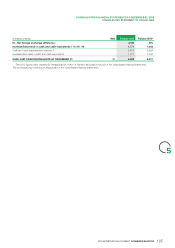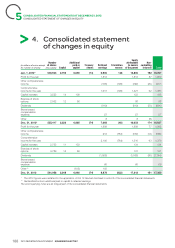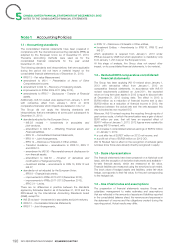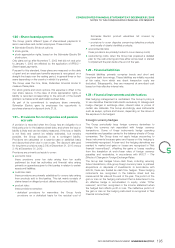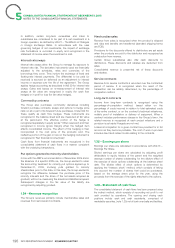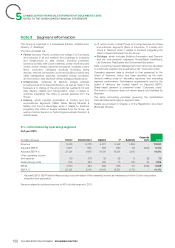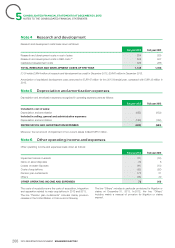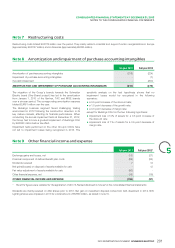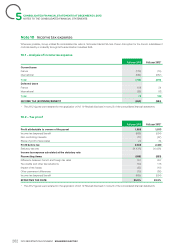APC 2013 Annual Report Download - page 195
Download and view the complete annual report
Please find page 195 of the 2013 APC annual report below. You can navigate through the pages in the report by either clicking on the pages listed below, or by using the keyword search tool below to find specific information within the annual report.
CONSOLIDATED FINANCIALSTATEMENTS ATDECEMBER 31, 2013
NOTES TO THE CONSOLIDATED FINANCIAL STATEMENTS
Borrowing costs Goodwill is allocated when initially recognized. The CGU
allocation is done on the same basis as used by Group
In accordance with IAS23R – Borrowing costs (applied as of management to monitor operations and assess synergies
January1, 2009), borrowing costs that are directly attributable to deriving from acquisitions.
the acquisition, construction or production of a qualifying asset Where the recoverable amount of an asset or CGU is lower than
are capitalized as part of the cost of the asset when it is probable its book value, an impairment loss is recognized for the excess of
that they will result in future economic benefits to the entity and the book value over the recoverable value. The recoverable value
the costs can be measured reliably. Other borrowing costs are is defined as the highest value between the value in use and the
recognized as an expense for the period. Prior to January1, realizable value net of costs. Where the tested CGU comprises
2009, borrowing costs were systematically expensed when goodwill, any impairment losses are firstly deducted there from.
incurred.
Non-current financial assets1.12 –
Impairment of assets1.11 –
Investments in non-consolidated companies are classified as
In accordance with IAS36 – Impairment of Assets – the Group available-for-sale financial assets. They are initially recorded at
assesses the recoverable amount of its long-lived assets as their cost of acquisition and subsequently measured at fair value,
follows: when fair value can be reliably determined.
for all property, plant and equipment subject to depreciation
l
The fair value of investments listed in an active market may be
and intangible assets subject to amortization, the Group determined reliably and corresponds to the listed price at
carries out a review at each balance sheet date to assess balance sheet date (Level 1 from the fair value hierarchy as per
whether there is any indication that they may be impaired. IFRS7).
Indications of impairment are identified on the basis of external
In cases where fair value cannot be reliably determined on
or internal information. If such an indication exists, the Group
observable markets, the investments are measured at cost net of
tests the asset for impairment by comparing its carrying
any accumulated impairment losses. The recoverable amount is
amount to the higher of fair value minus costs to sell and value
determined by assessing either the Group’ share in the entity’s
in use;
net assets or the expected future cash-flows representative of
non-amortizable intangible assets and goodwill are tested for
l
management expectation in this investment. This rule is applied
impairment at least annually and whenever there is an in particular to unlisted shares.
indication that the asset may be impaired.
Value in use is determined by discounting future cash flows that Changes in fair value are accumulated as other comprehensive
will be generated by the tested assets. These future cash flows income in the comprehensive income statement and, in balance
are based on Group management’s economic assumptions and sheet, in equity under “Other reserves” up to the date of sale, at
operating forecasts presented in forecasts over a period which time they are recognized in the income statement.
generally not exceeding 5 years, and then extrapolated based on Unrealized losses on assets that are considered to be
a perpetuity growth rate. The discount rate corresponds to the permanently impaired are recorded at the statement of income
Group’s weighted average cost of capital (WACC) at the under financial loss.
measurement date plus a risk premium depending on the region Loans, recorded under “Other non-current financial assets”, are
5
in question. The WACC stood at 7.8% at December31, 2013, a carried at amortized cost and tested for impairment where there
slight increase on the 7.7% at December31, 2012. This rate is is an indication that they may have been impaired. Non-current
based on (i) a long-term interest rate of 2.9%, corresponding to financial receivables are discounted when the impact of
the average interest rate for 10year OAT treasury bonds over the discounting is considered significant.
past few years, (ii) the average premium applied to financing
Inventories and work in process1.13 –
obtained by the Group in the fourth quarter of2013, and (iii) the
weighted country risk premium for the Group’s businesses in the
countries in question. Inventories and work in progress are measured at the lower of
The perpetuity growth rate was 2%, unchanged on the previous their initial recognition cost (acquisition cost or production cost
financial year. generally determined by the weighted average price method) or
Impairment tests are performed at the level of the of their estimated net realizable value.
cash-generating unit (CGU) to which the asset belongs. A Net realizable value corresponds to the estimated selling price
cash-generating unit is the smallest group of assets that net of remaining expenses to complete and/or sell the products.
generates cash inflows that are largely independent of the cash Inventory impairment losses are recognized in “Cost of sales”.
flows from other assets or groups of assets. The The cost of work in progress, semi-finished and finished
cash-generating units in2013, as in2012, are Partner,products, includes the cost of materials and direct labor,
Infrastructure, Industry, IT, Buildings and CST CGUs. Net assets subcontracting costs, all production overheads based on normal
were reallocated to the CGUs at the lowest possible level on the manufacturing capacity and the portion of research and
basis of the CGU activities to which they belong; the assets development costs that are directly related to the manufacturing
belonging to several activities were allocated to each CGU process (corresponding to the amortization of capitalized
(Power, Infrastructure and Industry mainly) pro-rata to their projects in production and product and range of products
revenue in that CGU. maintenance costs).
The WACC used to determine the value in use of each CGU was
8.0% for CST, 8.9% for Industry, 8.8% for Partner and IT, 8.1%
for Buildings and 9.0% for Infrastructure.
193
2013 REGISTRATION DOCUMENT SCHNEIDER ELECTRIC




